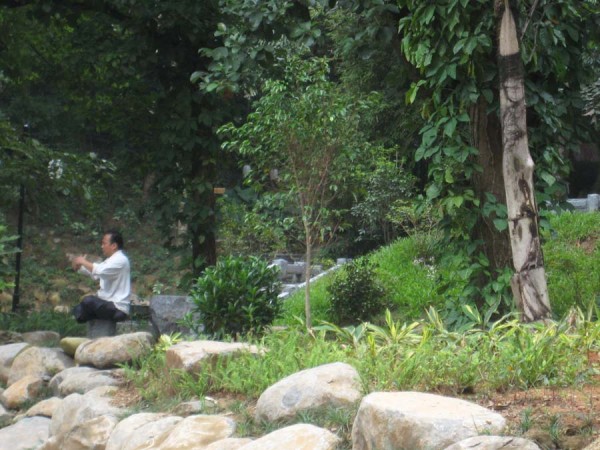We started out from the old but quiet town of Buluo and two hours later there we were at the arched entranceway of the Yellow Dragon Taoist Temple amid a general kafuffle of the herbalists and more shops that clutter the area by the car park that was rapidly filling with visiting group’s coaches. Wow, what a popular place!
Mila and Ly – my two lady escorts – followed the crowds, buying some of the items on display as these are not easily found elsewhere. However, not the unusual-to-our-eyes fungi and herbs in jars or spread on the pavement. Nor the live baby rats, still blind nor the wasp grubs – the honey yes, we bought jars of honey, leaving them with the shopkeeper until we returned from our temple tour.
We could have had our picture taken alongside Mao Tse Tung who was very well preserved in a waxwork vignette in one shop, but declined.
Eventually, there we were strolling past the bamboo groves and under huge bole trees of unknown age to reach Plum Blossom Hill, though no plum blossoms this season. However, White Lotus Lake did have lotus blooms to please.
The view from the first reaches of the ornamental lake with its ornate bridge and central pavilion opened up the vista of dark greenery that leads up into Loh Fau Shan, directly over the roofs of the ancient Chongxu Temple buildings. On the right, visitors were causing a fish-feeding frenzy of golden yellows as brightly coloured carp competed for morsels.
Stepping over the Encounter Immortals Bridge brought us to a well with central dragon looming from the water – Dragon Pond – it’s mouth wide open as visitors threw coins attempting to ‘hit the spot. Lot’s of fun.
Up the wide stone steps there was a Wishing Tree, festooned with a thousand and one red-tailed ‘wishes’ as people tossed their wish high in the air for it to land on a branch to let the wind carry the message into the mountain airs. Visitors happily sat under its shade, chatting, smoking, snacking, resting after paying respects to Immortal Lu Tung Pin – in his mortal days called Chun Yang, as Tung Pin (Dongbin) is his courtesy name.
A little further up and the Herb Washing Pool was found, quite large, a reminder that this place in its heyday was one of the four major herb trading centres of China.
Nearby, the Alchemical Furnace so-called, a stewing pot of particular dimensions for the seat, body and pot, where not-so-ordinary Lu became Immortal Lu, whereby which hot pot he correctly combined the ingredients of the Elixir of Immortality that legend tells us finally took him to Heaven.
Lu Tung Pin was a scholar of compassion with a genuine desire to help people obtain wisdom and enlightenment, and to get them into the Tao. However, he is often portrayed as having character flaws, not uncommon among the colourful Taoist Immortals, as all have eccentricities and he as chief, was no exception.
Reputed to be a ‘ladies man’, he is not invoked by people with romantic problems. He is portrayed as having bouts of drunkenness, which was not uncommon among the fun-loving Eight Immortals. This is also seen with several Taoist artists renown for their love of drinking. Lu was a productive poet and his works were collected in the Complete Tang Dynasty Poetry – “Quan Tang Shi”.
Lu is a historical figure who was mentioned in the official history book “History of Sung” and one of the earliest masters of the tradition of Internal Alchemy.
As to theory, Taoism can be seen with two distinct areas of involvement, the classical, which is mystical and stemmed primarily from Lao Tsu and Chuang Tsu, and the more popular magical and alchemical side of Taoism, this latter fulfilling the day-to-day needs of ordinary people plus the esoteric strivers.
At Loh Fau Shan the everyday aspect of Taoism was in full display but tucked away behind the main temple one meditating Taoist was closer to Lu’s teaching than all the others. There he sat, alone in the woods knitted into the Lotus posture, occasionally raising both arms above his head as if drawing down some hidden force. We didn’t disturb his practise.
In light of all the activity, on the outward and inward planes, what else for us to do other than choose a quiet lookout by the lakeside, unpack the three cups and the jar of Ke Jia Huang Jiu bought from the herb shops below, and toast Immortal Lu.
Meanwhile, the main hall of the quite ancient temple was abuzz with activity as the common folk burnt joss and bowed and prayed before the representations of The Taoist Immortals. Requests would be mundane but central to daily life of these believers, relating to health, success in various endeavours like examinations, medical operations and affairs of the heart.
For us, we would content ourselves this visit to that mellowing transformation that wine will bring about on a lazy sun filled afternoon among slight breezes and leaf tremors, among the footstep sounds of everyday Man also paying respects to Mr Lu and the benevolence of the Tao.
Just so, the three of us toasted the memory of Immortal Lu Tung Pin, at the Yellow Dragon Taoist Temple, on Loh Fau Shan, in Guangdong.
Who said there was no religious freedom in China?










